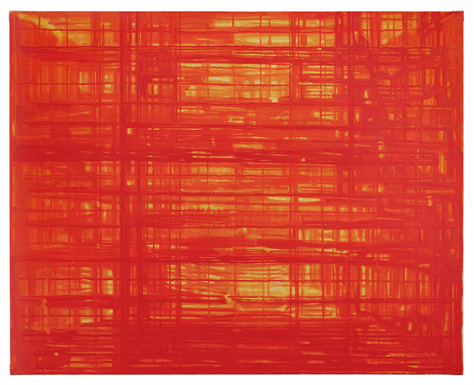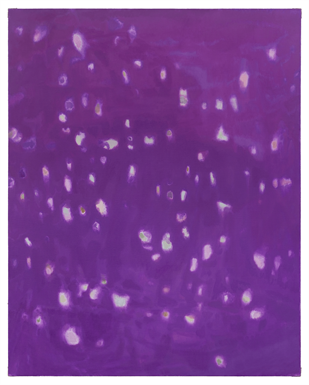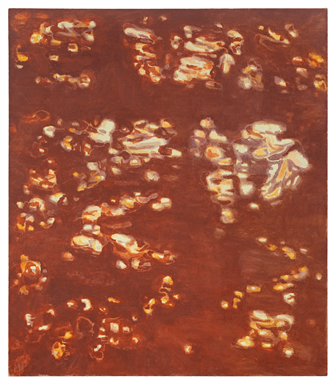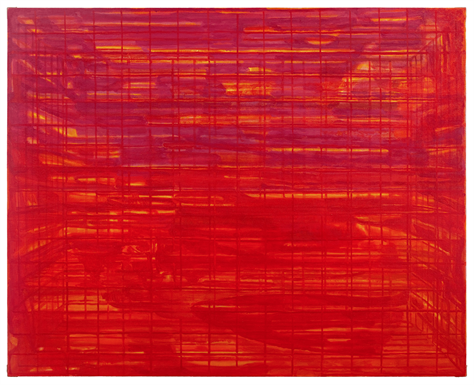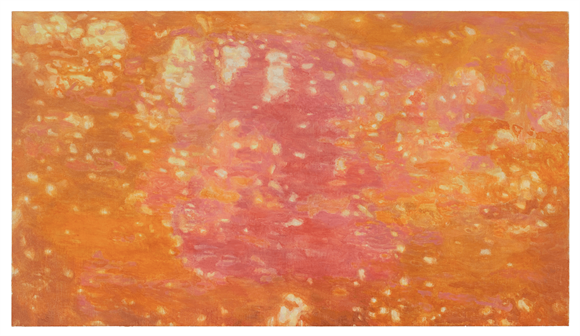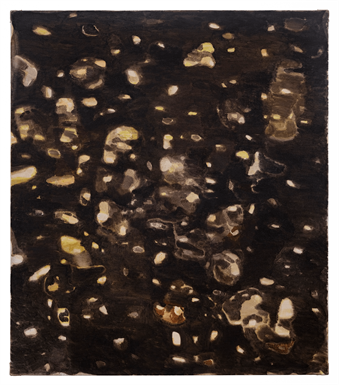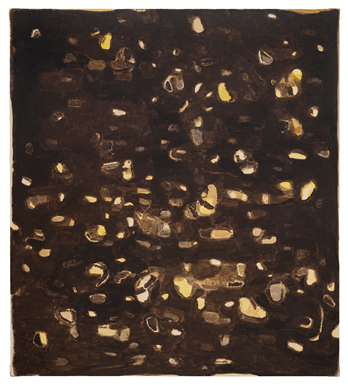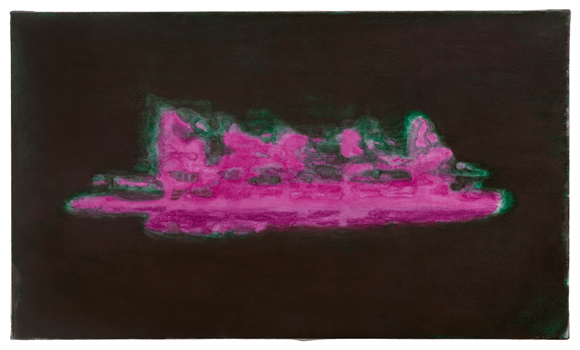Apr 30 - Jun 26, 2022
Press Release
Are the stars truly shining in the sky?
: A roundabout self-confession to the ‘devious nature of reproduction’, the basis for the existence of painting
This exhibition is a private exhibition introducing new artworks of Xu Xiaoguo(徐小国) who has worked on these pieces during the last three years. The exhibition is titled "The Stars(星光)." During translation, the English title ‘starlight’ may directly convey the Chinese title in a dictionary sense, but regarding main series such as ‘Starlight(星光)’ and ‘Cage(笼子)’ being included in the exhibition, a more comprehensive meaning was required. I hoped that a title that can cover different series was choses. In conclusion ‘The stars’ seemed most appropriate for it has the meaning of ‘starlight’ in addition to ‘star(星辰)’ therefore it can be interpreted in various ways.
Among the works exhibited in the "The Stars(星光)", there is a piece that draws attention personally. The title is 'Andrei Tarkovsky's birdcage(安德烈塔可夫斯基的鸟笼). As shown in the title, the famous Russian film director seems to guide us to a "mise en scène" binding us with intentional pressure and restraint. This exhibition hall becomes a huge cage set up by Andrei Tarkovsky. When I first encountered the artist's work, the general form of the cage that we remember was different from the cage expressed on the canvas screen which personally gave me an ambiguous feeling. To recognize the image of the work, the audience may have to check the title to understand what is being expressed. In this moment I began to wonder, how accurate are our memories then?
Memories are transformed, stored, and recalled.
In fact, memory has long been regarded as a channel of truth. A typical example is the witness’s testimony before a court. The witness takes a vow that he or she will not lie in court. The witness's testimony carries considerable weight and is adopted as legal evidence. It is because of the belief that if the witness tells the truth, memory will convey the truth of the past before us. This is because memory was considered to contain the truth from ancient to modern times. For example, the word for truth in Greek philosophy was ‘aletheia’, derived from the river of oblivion ‘lethe’ and indefinite prefix ‘a’ added in front of lethe (oblivion). Thus, the Greeks believed that truth was to recall the state of oblivion, that is, forgotten memory. Socrates assumes that the soul which was in IDEA (IDEA : perfect world) before birth knows the truth, but humans forget the truth because they have to cross the "Lethe" river when they are born. For Socrates, realizing truth was to recall the forgotten truth, so his teaching method was called the method to helping reminding of oneself, the maieutic(al) method.
This structure of oblivion and truth continues to the modern times, as said earlier in relation to the law, of how memory (and oblivion) remain connected. This trend remains the same for Sigmund Freud, who tried to explain the structure of the mind in his own way, where Freud placed the causes of various mental disorders, including hysteria, in suppressed unconsciousness, or oblivion.
For Freud, oblivion was like a shield that the ego used to retain itself. When confronting violent truths difficult for the ego to digest, oblivion operates to conceal and suppress them. However, memory is truth, therefore cannot cease to exist, thus repressed memory returns to torment the subject appearing as various mental diseases. This was Freud's explanation of the structure of memory and oblivion, and as Freud’s treatment, many people confessed the violence they experienced in their youth and regarded it as the cause of the symptoms of mental illness they now experience. However, according to psychologist Elizabeth Loftus, who wrote ‘The Myth of Repressed Memories and Allegation of Sexual Abuse’, memories can be distorted or manipulated as much as possible, and in contrary to the recent accusations of vivid events, it is dangerous to rely on so-called ‘suppressed memories’ to raise questions.
Does the equation ‘Memory = Truth’ establish? Memory transforms according to the benefits of life.
In fact, we still don't know so much about our memories. It is said that the hippocampus part of the brain controls memory and learning, but much more research is needed on how memories are stored and brought out again. One thing is clear. The equation ‘memory = truth’ we assumed in the past is wrong. Rather, it seems more reasonable to assume that memory, like other nervous systems, plays its role for survival and prosperity. Therefore, memories, at least old memories can be understood as being transformed, stored, and recalled for the benefit of life. If the equation of memory being the truth is wrong, how does the object that appears in the work of art really relate to our memory?
We tend not to pay attention to familiar everyday objects.
The reason is that they are always there as they should be, where they ought to be. However, suppose that we remove these things around us from their original place and locate them in an unfamiliar place. For example, let's say someone’s desk isn’t placed on the floor as it usually was, but is on the ceiling side by side with a nice chandelier. We will shake our heads being confused, saying, ‘Why?’, ‘How come?’, ‘How?’, and ‘What?’. Here, the objects that were dead in our unconscious minds only then revives brilliantly and is given a mysterious presence.
A work of art becomes a place where the presence (das Seiende, being) itself is revealed.
The exhibited series of artwork ‘Cage(笼子)’ and ‘Starlight(星光)’ shown in this exhibition expresses exaggerated reality or an imaginary world. The entire canvas is filled with birdcages and red-colored cages occupy most of the screen, or various shapes of stars such as petals or water droplets (different from the images of planets or universes we usually know through mass media) sparsely lights up or entirely fills the colorful background. In particular, the Chinese pronunciation of ‘Cage(笼子)’ is ‘lóngzi’. There is another word with the same pronunciation which is ‘聋子’. The meaning of this word is deaf. When I first encountered this work, I looked at the title and thought that I was trapped in a world of unconsciousness or a world of dream far from rational reality. In this concept of connoting a closed world, there are limits to raise one’s head to look upon the sky. I take ‘Starlight(星光)’ as an expression of this.
‘Absolute reality’, in other words, ‘Surréalité’ is expressed is this space, revealed without being dominated by logic, and without the interference of reason, to which Newton's law of motion does not apply. I found unexpected beauty buried in the artwork where I face reality in the unconscious world of the artist. As earlier expressed by Andre Bruton, this is the beauty of ‘le merveilleux’.
The earlier works of the artist were mainly conceptual, but going through changes, images were gradually erased from the screen and progressed towards non-conceptual work. Those who are familiar with his work can see through these changes in composition of how the artist rejects the former system of reproduction and communication and ignores the logical law of proportionality of nature. An ambiguous boundary between the reproduced reality and the actual reality is seen through the work. Through this, we raise doubt on the reality itself that is said to clearly exist. The act of reproduction in painting is basically based on deception. Therefore, the works shown in this exhibition also appear to be indirect self-confessions about the ‘deception of reproduction’ which is the basis of the existence of painting. Art which lives and breathes is a work of art that reveals the truth of existence in the work itself, and in the same time, this truth of existence has a double-sidedness of being both subjective and objective.
Art deals with time. Art provides time to think about memories and to trace memories back in time that are not visible. Let us take our precious time to understand and think about the work of the artist and the audience who are joining the exhibition at this moment in the unprecedented pandemic situation,that the present is a continuation of the present which contains memories of the past and expectations of the future in itself.
Curator Article
Are the stars truly shining in the sky?
: A roundabout self-confession to the ‘devious nature of reproduction’, the basis for the existence of painting
LEE Janguk
This exhibition is a private exhibition introducing new artworks of Xu Xiaoguo(徐小国) who has worked on these pieces during the last three years. The exhibition is titled "The Stars(星光)." During translation, the English title ‘starlight’ may directly convey the Chinese title in a dictionary sense, but regarding main series such as ‘Starlight(星光)’ and ‘Cage(笼子)’ being included in the exhibition, a more comprehensive meaning was required. I hoped that a title that can cover different series was choses. In conclusion ‘The stars’ seemed most appropriate for it has the meaning of ‘starlight’ in addition to ‘star(星辰)’ therefore it can be interpreted in various ways.
Among the works exhibited in the "The Stars(星光)", there is a piece that draws attention personally. The title is 'Andrei Tarkovsky's birdcage(安德烈塔可夫斯基的鸟笼). As shown in the title, the famous Russian film director seems to guide us to a "mise en scène" binding us with intentional pressure and restraint. This exhibition hall becomes a huge cage set up by Andrei Tarkovsky. When I first encountered the artist's work, the general form of the cage that we remember was different from the cage expressed on the canvas screen which personally gave me an ambiguous feeling. To recognize the image of the work, the audience may have to check the title to understand what is being expressed. In this moment I began to wonder, how accurate are our memories then?
Memories are transformed, stored, and recalled.
In fact, memory has long been regarded as a channel of truth. A typical example is the witness’s testimony before a court. The witness takes a vow that he or she will not lie in court. The witness's testimony carries considerable weight and is adopted as legal evidence. It is because of the belief that if the witness tells the truth, memory will convey the truth of the past before us. This is because memory was considered to contain the truth from ancient to modern times. For example, the word for truth in Greek philosophy was ‘aletheia’, derived from the river of oblivion ‘lethe’ and indefinite prefix ‘a’ added in front of lethe (oblivion). Thus, the Greeks believed that truth was to recall the state of oblivion, that is, forgotten memory. Socrates assumes that the soul which was in IDEA (IDEA : perfect world) before birth knows the truth, but humans forget the truth because they have to cross the "Lethe" river when they are born. For Socrates, realizing truth was to recall the forgotten truth, so his teaching method was called the method to helping reminding of oneself, the maieutic(al) method.
This structure of oblivion and truth continues to the modern times, as said earlier in relation to the law, of how memory (and oblivion) remain connected. This trend remains the same for Sigmund Freud, who tried to explain the structure of the mind in his own way, where Freud placed the causes of various mental disorders, including hysteria, in suppressed unconsciousness, or oblivion.
For Freud, oblivion was like a shield that the ego used to retain itself. When confronting violent truths difficult for the ego to digest, oblivion operates to conceal and suppress them. However, memory is truth, therefore cannot cease to exist, thus repressed memory returns to torment the subject appearing as various mental diseases. This was Freud's explanation of the structure of memory and oblivion, and as Freud’s treatment, many people confessed the violence they experienced in their youth and regarded it as the cause of the symptoms of mental illness they now experience. However, according to psychologist Elizabeth Loftus, who wrote ‘The Myth of Repressed Memories and Allegation of Sexual Abuse’, memories can be distorted or manipulated as much as possible, and in contrary to the recent accusations of vivid events, it is dangerous to rely on so-called ‘suppressed memories’ to raise questions.
Does the equation ‘Memory = Truth’ establish? Memory transforms according to the benefits of life.
In fact, we still don't know so much about our memories. It is said that the hippocampus part of the brain controls memory and learning, but much more research is needed on how memories are stored and brought out again. One thing is clear. The equation ‘memory = truth’ we assumed in the past is wrong. Rather, it seems more reasonable to assume that memory, like other nervous systems, plays its role for survival and prosperity. Therefore, memories, at least old memories can be understood as being transformed, stored, and recalled for the benefit of life. If the equation of memory being the truth is wrong, how does the object that appears in the work of art really relate to our memory?
We tend not to pay attention to familiar everyday objects.
The reason is that they are always there as they should be, where they ought to be. However, suppose that we remove these things around us from their original place and locate them in an unfamiliar place. For example, let's say someone’s desk isn’t placed on the floor as it usually was, but is on the ceiling side by side with a nice chandelier. We will shake our heads being confused, saying, ‘Why?’, ‘How come?’, ‘How?’, and ‘What?’. Here, the objects that were dead in our unconscious minds only then revives brilliantly and is given a mysterious presence.
A work of art becomes a place where the presence (das Seiende, being) itself is revealed.
The exhibited series of artwork ‘Cage(笼子)’ and ‘Starlight(星光)’ shown in this exhibition expresses exaggerated reality or an imaginary world. The entire canvas is filled with birdcages and red-colored cages occupy most of the screen, or various shapes of stars such as petals or water droplets (different from the images of planets or universes we usually know through mass media) sparsely lights up or entirely fills the colorful background. In particular, the Chinese pronunciation of ‘Cage(笼子)’ is ‘lóngzi’. There is another word with the same pronunciation which is ‘聋子’. The meaning of this word is deaf. When I first encountered this work, I looked at the title and thought that I was trapped in a world of unconsciousness or a world of dream far from rational reality. In this concept of connoting a closed world, there are limits to raise one’s head to look upon the sky. I take ‘Starlight(星光)’ as an expression of this.
‘Absolute reality’, in other words, ‘Surréalité’ is expressed is this space, revealed without being dominated by logic, and without the interference of reason, to which Newton's law of motion does not apply. I found unexpected beauty buried in the artwork where I face reality in the unconscious world of the artist. As earlier expressed by Andre Bruton, this is the beauty of ‘le merveilleux’.
The earlier works of the artist were mainly conceptual, but going through changes, images were gradually erased from the screen and progressed towards non-conceptual work. Those who are familiar with his work can see through these changes in composition of how the artist rejects the former system of reproduction and communication and ignores the logical law of proportionality of nature. An ambiguous boundary between the reproduced reality and the actual reality is seen through the work. Through this, we raise doubt on the reality itself that is said to clearly exist. The act of reproduction in painting is basically based on deception. Therefore, the works shown in this exhibition also appear to be indirect self-confessions about the ‘deception of reproduction’ which is the basis of the existence of painting. Art which lives and breathes is a work of art that reveals the truth of existence in the work itself, and in the same time, this truth of existence has a double-sidedness of being both subjective and objective.
Art deals with time. Art provides time to think about memories and to trace memories back in time that are not visible. Let us take our precious time to understand and think about the work of the artist and the audience who are joining the exhibition at this moment in the unprecedented pandemic situation,that the present is a continuation of the present which contains memories of the past and expectations of the future in itself.




